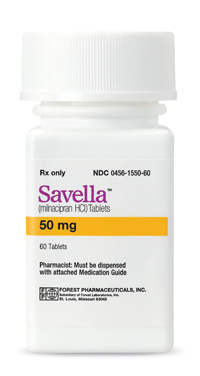Product
Savella (milnacipran HCl)
Approval Date
January 14, 2009
Release Date
April 24, 2009
Company
Forest Laboratories and Cypress Bioscience
Class
A selective serotonin and norepinephrine dual-reuptake inhibitor.
Indication
The management of fibromyalgia
Active Ingredient
Milnacipran Hydrochloride
Agency Roster
No outside agency involvement.
Marketing Strategy/Execution
Savella will be marketed directly to physicians via sales reps and professional journals. It will be positioned as a first line treatment for fibromyalgia. Savella will be marketed by Forest and its licensor Cypress Bioscience. Pierre Fabre, who originally developed and sells milnacipran outside the US, licensed the rights for North America to Cypress Bioscience.
Physician Outlook
Savella and Eli Lilly’s Cymbalta’s are both serotoinin-norepinephrine reuptake inhibitors approved for fibromyalgia in the last six months (Cymbalta in June 2008), Savella appears to have greater selectivity for blocking norepinephrine which offers a unique MOA relative to Cymbalta. Doctors and patients will likely be impressed by Savella’s clinical trial design which required concurrent patient improvement on several dimensions: pain, patient global assessment of change and physical functioning. Studies show patients put particular importance on improved daily functioning in addition to pain management.
— Geoff Penney, Vice President, Category Business Leader, GfK Healthcare
Also in the Pipeline (courtesy of Adis R&D Insight)
Drug: Desvenlafaxine
Manufacturer: Wyeth
Indication: Depression
Active ingredient: Desvenlafaxine SR
Phase: Launched
Drug: AropaxÂ
Manufacturer: Novo Nordisk / Chiesi
Indication: Depression
Active ingredient: Paroxetine
Phase: Launched
Drug: Reboxetine
Manufacturer: Pfizer / Juste
Indication: Depression
Active ingredient: Reboxetine
Phase: Launched
Drug: Gamma-hydroxybutyrate
Manufacturer: Jazz Pharmaceuticals / UCB
Indication: Cataplexy
Active ingredient: Sodium oxybate
Phase: Launched
Source: Wolters Kluwer Health
Pharmacology
Detailed clinical information withheld for review by MPR’sclinical advisory board and will be added as soon as it becomes available.
Clinical Trials
Detailed clinical information withheld for review by MPR’sclinical advisory board and will be added as soon as it becomes available.
Adverse Reactions
GI upset, headache, constipation, dizziness, insomnia, hot flush, hyperhidrosis, palpitations, increased heart rate, dry mouth, hypertension; rare: GU effects in men; hyponatremia (esp. in elderly); serotonin syndrome; seizure.
Adults
May take with food. Titrate dose. Day 1: 12.5mg once. Days 2–3: 12.5mg twice daily. Days 4–7: 25mg twice daily. After Day 7: 50mg twice daily (recommended dose); max 100mg twice daily. Severe renal impairment (CrCl 5–29mL/min): maintenance 25mg twice daily; max 50mg twice daily. Withdraw gradually.
Children
<17yrs: not recommended.Contraindications
Allow at least 14 days after MAOI discontinuance before starting milnacipran; allow at least 5 days after discontinuing milnacipran before starting an MAOI. Uncontrolled narrow-angle glaucoma.
Precautions
Substantial alcohol abuse, chronic liver disease, end stage renal disease: not recommended. Hypertension. Heart disease. Arrhythmias. Monitor BP and heart rate; reduce dose or discontinue if elevated BP persists. Controlled narrow-angle glaucoma. Seizure disorder. Suicidal ideation (monitor). Mania. Severe hepatic dysfunction. Discontinue if liver dysfunction develops. Volume depleted. GU obstruction. Aspirin allergy (tartrazine). Risk of bleeding. Reevaluate periodically. Write Rx for smallest practical amount. Pregnancy (Cat.C; see literature for effects on fetus). Labor & delivery, nursing mothers: not recommended.
Interactions
See Contraindications. Concomitant serotonin precursors (eg, tryptophan), serotonergics (eg, triptans, tramadol): not recommended. Avoid IV digoxin (postural hypotension, tachycardia). May potentiate anticoagulants (eg, aspirin, NSAIDs, coumadin). May antagonize certain antihypertensives (eg. clonidine). Serotonin syndrome with SSRIs, SNRIs, lithium, tramadol, triptans (monitor). Caution with other CNS-active drugs or those that can increase BP. Arrhythmias, hypertension with epinephrine, norepinephrine.








